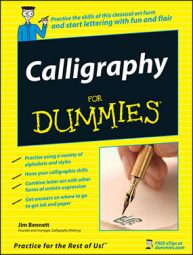The pens you use to make beautiful calligraphy aren't at all complicated. Their basic design is simple, efficient, and centuries old. A good pen delivers the ink in an even flow and should make it easy for you to create strokes. The pen should glide smoothly on the surface of the paper.
This list should help get you better acquainted with your calligraphy pens:
- Nib: This is the part of the pen that everyone else refers to as the pen point. Calligraphy nibs have a flat edge similar in appearance to a flat screwdriver and come in a variety of sizes. Markers have nibs that are permanently attached. Fountain pens have nibs that are interchangeable and screw into the barrel of the pen. They usually come in sets. Dip pens have steel nibs that slide into a curved slot in the end of a pen handle. The selection of sizes is much bigger than for fountain pen nibs. Dip pen nibs are available individually.
- Cartridge: All the popular calligraphy fountain pens use ink cartridges. Cartridges are the newest addition to the design of calligraphy pens and make using the pen simple and virtually mess-free. The biggest problem with cartridges is getting a new pen started writing. The ink has to flow from the cartridge down to the tip of the pen before it will write, and that does not happen automatically. Sometimes you have to work at getting the pen started.
- Adapter: This takes the place of ink cartridges and makes it possible for you to fill your fountain pen with ink from a bottle. Perhaps it's "old school," but it's a good idea to be able to fill your pen from a bottle and not rely on using cartridges in your pen. The cartridges are small and easy to misplace; the bottle isn't. Although filling the pen from a bottle has a greater potential for creating a mess than using cartridges, a pen that is filled from a bottle will start writing faster than pens that have cartridges.
- Handles or pen holders: Dip pens have handles that are simple wooden or plastic shafts ranging in length from 5 to 7 inches. The nibs are inserted in the ends. Select a handle that fits your nibs and feels comfortable in your hand. Varnished wooden handles are the best choice; plastic is okay. Avoid painted handles because the paint will eventually chip away.
- Reservoir: Most dip pen nibs are designed to be used with this small attachment that holds the ink. It is frequently made of brass that is soft enough to be shaped with your fingers. Some dip pen nibs have a reservoir on top and some have it on the bottom. Most of the reservoirs can be removed from the nib to make cleaning easy. At least one kind of nib has a reservoir that cannot be removed.

